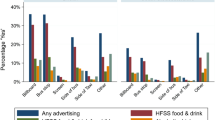Abstract
Unhealthful food-and-beverage advertising often targets vulnerable groups. The extent of such advertising in subway stations has not been reported and it is not clear how ad placement may relate to subway ridership or community demographics, or what the implications might be for diets and diet-related health in surrounding communities. Riding all subway lines (n = 7) in the Bronx, NY, USA, investigators systematically assessed all print ads (n = 1586) in all stations (n = 68) in 2012. Data about subway ridership came from the Metropolitan Transportation Authority. Demographic data on surrounding residential areas came from the U.S. Census Bureau. Data on dietary intake and diet-related conditions came from a city health-department survey. There were no ads promoting “more-healthful” food-or-beverage items (i.e., fruits, vegetables, whole grains, nuts, water or milk). There were many ads for “less-healthful” items (e.g., candies, chips, sugary cereals, frozen pizzas, “energy” drinks, coffee confections, hard alcohol, and beer). Ad placement did not relate to the number of riders entering at stations. Instead, exposure to food-or-beverage ads generally, and to “less-healthful” ads particularly (specifically ads in Spanish, directed at youth, and/or featuring minorities), was directly correlated with poverty, lower high-school graduation rates, higher percentages of Hispanics, and/or higher percentages of children in surrounding residential areas. Correlations were robust to sensitivity analyses. Additional analyses suggested correlations between ad exposures and sugary-drink consumption, fruit-and-vegetable intake, and diabetes, hypertension, and high-cholesterol rates. Subway-station ads for “less-healthful” items were located disproportionately in areas home to vulnerable populations facing diet and diet-related-health challenges. The fact that uneven ad placement did not relate to total rider counts suggests ads were not directed at the largest possible audiences but rather targeted to specific groups.
Similar content being viewed by others
References
Harris JL, Weinberg M, Javadizadeh J, Vishnudas Sarda. Chapter 7: monitoring food company marketing to children to spotlight best and worst practices. In: Williams JD, et al, editors. Advances in communication research to reduce childhood obesity. doi:10.1007/978-1-4614-5511-0_7. © Springer Science+Business Media New York 2013.
Cheyne A, Gonzalez P, Mejia P, Dorfman L. Food and beverage marketing to children and adolescents: limited progress by 2012. Minneapolis, MN: Healthy Eating Research; 2013. Available at: http://www.healthyeatingresearch.org/. Accessed 20 April 2015.
Federal Trade Commission. A review of food marketing to children and adolescents—follow-up report. December 2012. Available at: https://www.ftc.gov/reports/review-food-marketing-children-adolescents-follow-report.
Kunkel D, Mastro D, Ortiz M, McKinley C. Food marketing to children on U.S. Spanish-language television. J Health Commun. 2013.
Yancey AK, Cole BL, Brown R, et al. A cross-sectional prevalence study of ethnically targeted and general audience outdoor obesity-related advertising. Milbank Q. 2009; 87(1): 155–184.
Lowery BC, Sloane DC. The prevalence of harmful content on outdoor advertising in Los Angeles: land use, community characteristics, and the spatial inequality of a public health nuisance. Am J Public Health. 2014; 104(4): 658–664.
Hillier A, Cole BL, Smith TE, et al. Clustering of unhealthy outdoor advertisements around child-serving institutions: a comparison of three cities. Health & Place. 2009; 15(4): 935–945.
Gentry E, Poirier K, Wilkinson T, Nhean S, Nyborn J, Siegel M. Alcohol advertising at Boston subway stations: an assessment of exposure by race and socioeconomic status. Am J Public Health. 2011; 101(10): 1936–1941.
Nyborn JA, Wukitsch K, Nhean S, Siegel M. Alcohol advertising on Boston’s Massachusetts Bay Transportation Authority transit system: an assessment of youths’ and adults’ exposure. Am J Public Health. 2009; 99(Suppl 3): S644–648.
Dietary guidelines for Americans 2015–2020: eighth edition. For professionals: recommendations at-a-glance. March 2016; https://health.gov/dietaryguidelines/2015/resources/DGA_Recommendations-At-A-Glance.pdf. Accessed November 22, 2016.
MTA. Introduction to subway ridership. http://web.mta.info/nyct/facts/ridership/. Accessed June 11, 2016.
U.S. Census Bureau. 2010 Census Summary File 1, Table P12. http://factfinder2.census.gov. Accessed June 11, 2016.
U.S. Census Bureau. 2010 American Community Survey 5-year estimate, Tables DP02 abd DP03. http://factfinder2.census.gov. Accessed June 11, 2016.
NYC Health. Community Health Survey. https://a816-healthpsi.nyc.gov/epiquery/CHS/CHSXIndex.html. Accessed June 11, 2016.
NYC Health. BES data reliability flowchart. https://a816-healthpsi.nyc.gov/epiquery/CHS/BES data reliability.pdf. Accessed June 11, 2016.
Kelly B, Cretikos M, Rogers K, King L. The commercial food landscape: outdoor food advertising around primary schools in Australia. Aust N Z J Public Health. 2008; 32(6): 522–528.
Ohri-Vachaspati P, Isgor Z, Rimkus L, Powell LM, Barker DC, Chaloupka FJ. Child-directed marketing inside and on the exterior of fast food restaurants. Am J Prev Med. 2014.
Pasch KE, Komro KA, Perry CL, Hearst MO, Farbakhsh K. Outdoor alcohol advertising near schools: what does it advertise and how is it related to intentions and use of alcohol among young adolescents? J Studies Alcohol Drugs. 2007; 68(4): 587–596.
Kwate NO, Meyer IH. Association between residential exposure to outdoor alcohol advertising and problem drinking among African American women in New York City. Am J Public Health. 2009; 99(2): 228–230.
Lesser LI, Zimmerman FJ, Cohen DA. Outdoor advertising, obesity, and soda consumption: a cross-sectional study. BMC Public Health. 2013; 13: 20.
Isgor Z, Powell L, Rimkus L, Chaloupka F. Associations between retail food store exterior advertisements and community demographic and socioeconomic composition. Health & Place. 2016; 39: 43–50.
Scott MM, Cohen DA, Schonlau M, Farley TA, Bluthenthal RN. Alcohol and tobacco marketing: evaluating compliance with outdoor advertising guidelines. Am J Prev Med. 2008; 35(3): 203–209.
Kwate NO, Jernigan M, Lee T. Prevalence, proximity and predictors of alcohol ads in Central Harlem. Alcohol Alcohol. 2007; 42(6): 635–640.
Hackbarth DP, Schnopp-Wyatt D, Katz D, Williams J, Silvestri B, Pfleger M. Collaborative research and action to control the geographic placement of outdoor advertising of alcohol and tobacco products in Chicago. Public Health Rep. 2001; 116(6): 558–567.
MTA. MTA advertising standards. http://web.mta.info/mta/realestate/PDF/MTA_Ad_Policy_April_2015.PDF. Accessed May 7, 2016.
Kevin Quealy, Margot Sanger-Katz. Is sushi ‘healthy’? What about granola? Where Americans and nutritionists disagree. The New York Times, July 5, 2016.
Acknowledgements
The authors would like to offer sincere posthumous thanks to Hope M. Spano for intern coordination and project assistance. SL is supported by the Eunice Kennedy Shriver National Institute of Child Health and Human Development of the National Institutes of Health under award K23HD079606. The content of this manuscript is solely the responsibility of SL and does not necessarily represent the official views of the National Institutes of Health. OS received a student stipend to participate in this research from the Hispanic Center of Excellence at the Albert Einstein College of Medicine, which had no role in the study design; collection, analysis, or interpretation of data; writing the report; or the decision to submit the report for publication. SL conceived the study, performed the literature review, designed the data collection protocol, oversaw primary data collection, performed all analyses, and drafted the manuscript, including tables and figures. AM retrieved all secondary sources of data (from the MTA, the U.S. Census Bureau, and the city health department), assisted with analyses and data interpretation, created all maps, and helped revise the manuscript. OS performed primary data collection (in the subway system), assisted with data analysis and interpretation, and helped revise the manuscript. CS oversaw and assisted with data analysis and helped revise the manuscript. SL serves as a member of the Scientific and Nutritional Advisory Board for Epicure. None of the other authors have any disclosures. The authors would like to thank Andrew Carmona and Mamadou Bah for their help with data collection.
Author information
Authors and Affiliations
Corresponding author
Appendix
Appendix
Rights and permissions
About this article
Cite this article
Lucan, S.C., Maroko, A.R., Sanon, O.C. et al. Unhealthful Food-and-Beverage Advertising in Subway Stations: Targeted Marketing, Vulnerable Groups, Dietary Intake, and Poor Health. J Urban Health 94, 220–232 (2017). https://doi.org/10.1007/s11524-016-0127-9
Published:
Issue Date:
DOI: https://doi.org/10.1007/s11524-016-0127-9





